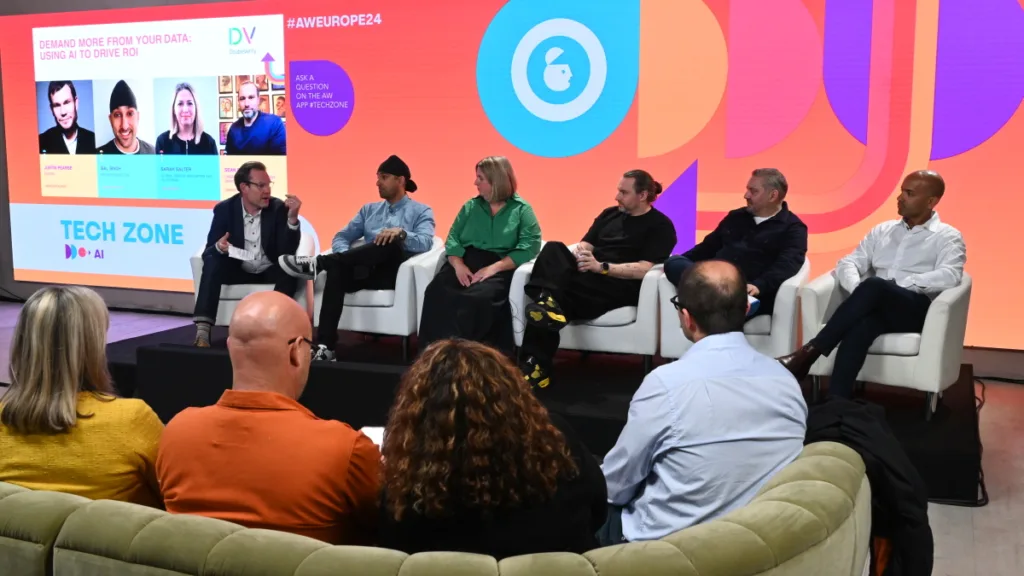Brands have more data at their fingertips than ever before, but are often faced with the hurdle of not being entirely clear on how to utilise this data to optimise their media strategy. And the key to be able to unlock this data is likely to lie in the way that the much-talked about technology of artificial intelligence (AI) is applied.
This is the topic that was broached at Advertising Week Europe on the ‘Demand more from your data: Using AI to drive ROI’ panel, sponsored by DoubleVerify.
So, how can brands work with their agencies to get the most out of their data through the use of AI?
Time is of the essence
According to Sarah Salter, Global Head of Innovation and Platforms at Wavemaker, AI really delivers for brands and agencies when it’s used for “augmenting human creativity,” and freeing up time within teams.
“I sit on a number of our client taskforces, and I’m hearing numbers like ‘we’re getting 10 hours back for our teams and our teams are being more proactive in how they think about ideation, how they think about optimisation, all of these different things.’ So, getting time back because I feel like it’s got busier and busier, and to be able to have more time to create, and to think, and to do what it is that we love is really exciting,” said Salter
Th ability of AI technology to “open up opportunities” and free up teams to do better work is also where Ricky Chopra, Global Digital Business Director at Zenith, sees the technology doing some of its best work.
“It’s allowing us to do more with the same number of people. For example, traditionally, there have been business questions it’s been very difficult and expensive to answer. With AI, people are able to answer these business questions with the aid of AI and AI tools. So, that’s where I see this going,” said Chopra. “It’s going to democratise business intelligence and enable us to answer more business questions.
“It’s people augmented with technology as the solution, not replacing people with technology.”
Trust in the process
Alongside AI being capable of equipping “our talent to be able to connect that data in ways that can actually make better decision,” John Thankamony, Managing Director – Addressable Media & Total Commerce UK at Dentsu, sees great potential for AI to be used for helping to build consumer trust in the content they’re seeing.
“There’s a place for trusted environments. There’s a big case for the right platforms; the trust around that; the content itself, around how we fix it and manage it; and then the tools,” said Thankamony. “We’ve seen a lot of instances where you can see AI used to build out, but we can also see it for fact checking.”
To this point, Bal Singh, Business Director at DoubleVerify, added that – having previously worked for a premium publisher – “one of the risks at the moment is there’s a big difference between premium newsbrands who have journalists who are checking their facts, have their sources, are drafting their copy, and are using AI to help steer that. There’s a big difference between that and some clickbait trash with an automated headline, automated content, that just spouts out anything that is probably misinformation. That’s the stuff you need to avoid.”
However, because of fear of the latter, “there’s a risk with clients at the moment, where they’re going ‘anything with AI, I don’t want to touch it,’ and that’s not the approach to go for.”
Finding a balance
While AI is going to form a major part of the strategies of a large number of businesses – whether advertisers or publishers – Sean Betts, Chief Product & Technology Officer at Omnicom Media Group, believes it’s important for agencies to understand that not all clients are going to want to see the technology used.
“We’re seeing some clients who are really pushing us hard to develop new capabilities and to use them in their campaigns. Then we’ve got other clients who are very clear that they don’t want even the most basic machine learning algorithms to optimise their digital media campaigns. And there’s a whole raft of people in the middle,” said Betts. “The top 5% are pushing really hard, but the bottom 5% are never going to look at this stuff – and probably won’t, even in a couple of years.
“That presents us with some interesting challenges, because we want to be able to cater for clients of all sizes and different policies and appetite for different technology, so we have to balance what we can do.”
*DoubleVerify is a client of Bluestripe Communications, owned by Bluestripe Group, publisher of NDA







